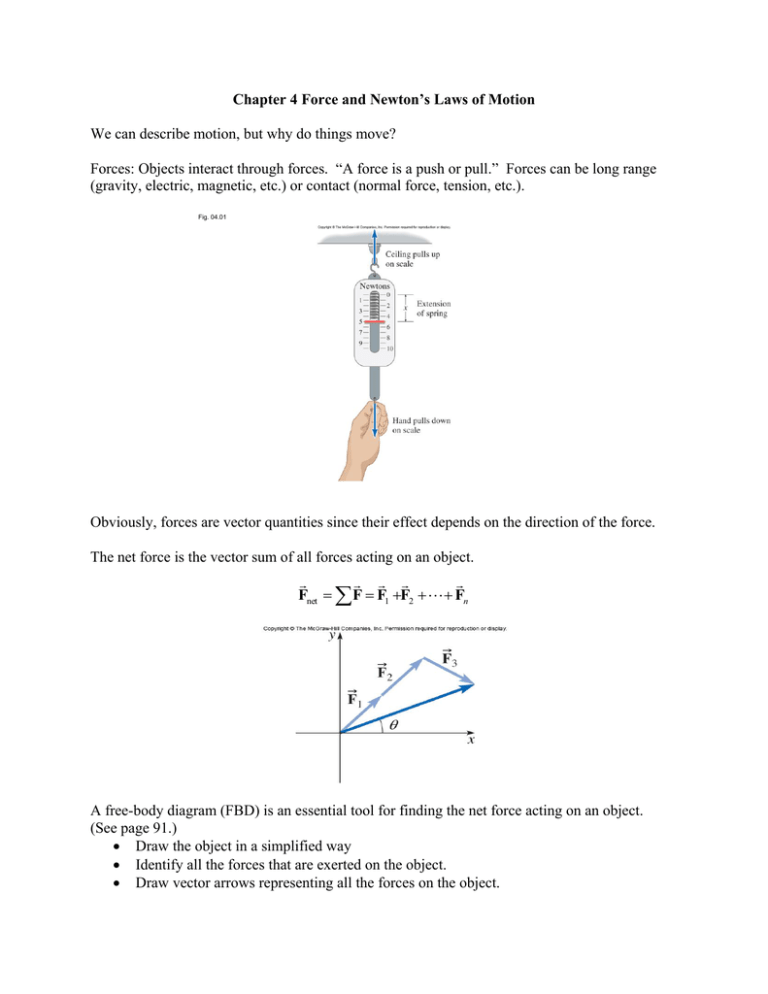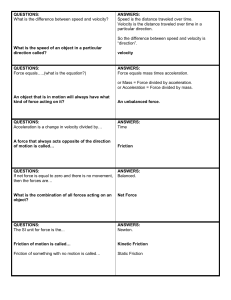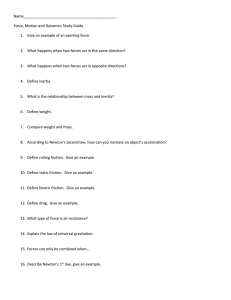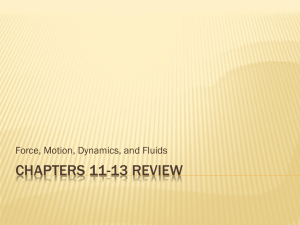Chapter 4 Force and Newton’s Laws of Motion
advertisement

Chapter 4 Force and Newton’s Laws of Motion We can describe motion, but why do things move? Forces: Objects interact through forces. “A force is a push or pull.” Forces can be long range (gravity, electric, magnetic, etc.) or contact (normal force, tension, etc.). Fig. 04.01 Obviously, forces are vector quantities since their effect depends on the direction of the force. The net force is the vector sum of all forces acting on an object. Fnet F F1 F2 Fn A free-body diagram (FBD) is an essential tool for finding the net force acting on an object. (See page 91.) Draw the object in a simplified way Identify all the forces that are exerted on the object. Draw vector arrows representing all the forces on the object. Examples 1. 2. 3. 4. Freely falling object. Object hanging from a rope. Object sitting on a horizontal table. Object sitting on a horizontal table being pulled by a rope. FREE BODY DIAGRAMS GO HERE. I will draw them on the board. Drawing the free-body diagram is the key to solving problems. Newton’s First Law (law of inertia): An object’s velocity vector v remains constant if and only if the net force acting on the object is zero. An object moving at constant velocity has no net force! A revolutionary idea. An object moving at constant velocity is said to be in translational equilibrium. That velocity could be zero. Inertia is the resistance to changes in velocity. Newton’s Second law: The rate of change of an object’s velocity is proportional to the net force acting on it and inversely proportional to its mass. F ma Recall our rule: we never deal with vectors, we deal with their components. A far more useful form of Newton’s second law will be F x ma x F y ma y The left hand side is supplied by the free-body diagram. The right hand side is supplied by our knowledge of the motion. The SI unit of force is the newton. 1 N = 1 kg·m/s2. What is mass? Mass is a measure of inertia. Mass is not the same as weight. Newton’s Third Law: In an interaction between two objects, each object exerts a force on the other. These forces are equal in magnitude and opposite in direction. It two objects A and B are exerting forces on each other, A B FAB FBA FAB FBA The forces are equal in magnitude and opposite in direction. Newton’s Laws of Motion (pages 92-99) 1. An object’s velocity vector v remains constant if and only if the net force acting on the object is zero. 2. When a nonzero net force acts on an object, the object’s velocity changes. The object’s acceleration if proportional to the net force acting on it and inversely proportional to its mass. F x ma x F y ma y 3. In an interaction between two objects, each object exerts a force on the other. These forces are equal in magnitude and opposite in direction. FAB FBA Interaction Pairs A simple example: I push down on the table with a force of 15 pounds. The table pushes up on me with a force of 15 pounds. A little harder example. A block sits at rest on a flat surface. The block is held down by its weight. What is the interaction pair for the weight? N W Answer: It is not the normal force! The weight is the force of the earth pulling down on the object. The interaction pair is the object pulls up on the earth. To find the reaction to the action, switch nouns and directions. The third law paradox. If I exert a 15 pound force on a chair, by Newton’s third law, the chair will pull back with a 15 pound force. The forces are equal in magnitude and opposite in direction, so they cancel. I cannot move the chair. Obviously, I can move the chair. Why? The 15 pound forces act on different systems. The net force on the chair is the difference between by 15 pound force and the friction acting on the chair as it moves across the floor. As long as I can push harder than friction, the chair will accelerate in the direction I am pushing. Gravitational Forces We already argued the magnitude of the weight can be written as W mg Why do things have weight? The earth pulls down on them. Why? No one really knows. How does it pull down? The earth is not touching the ball yet it still pulls down. How does the earth pull it down? No one really knows. General relativity explains some aspects of gravity, but the interaction mechanism is unexplained. String theory? Newton postulated that two mass m1 and m2 are attracted to each other by a force given by F Gm1m2 r2 where r is the distance between the two masses and G 6.67 1011 N m 2 /kg 2 is the universal gravitational constant. Since G is so small, it takes a lot of mass (a planet for instance) to experience a sizable gravitational force. Since the gravitational force causes an object to have weight, it can be shown (see pages 100-101) that g GM E RE 2 ME is the mass of the earth and RE its radius. Contact Forces Normal force N is the force of a surface pushing up on an object. It is a force of constraint that forces the object to only move along the surface. Accordingly it is perpendicular to the surface (hence its name, normal force). In the first case, the normal force is equal in magnitude to the weight. But in the other two cases, they are not equal. Friction force f is the force of a surface opposing the motion of the object. The surface “holds onto” the object and resists its motion. v f The normal force and the friction force are components of the force of the surface acting on the object. Friction 1. Friction must depend on the surfaces in contact. Some surfaces are more slippery than others. Surface properties is contained in a property called the coefficient of friction, . 2. Friction must also depend on the forces between surfaces. Heavy objects have more friction than light objects. The force property is the normal force, N. This is only an approximation for friction. Friction is actually very complicated. This model is useful because it is fairly easy to use in our exercises. Kinetic Friction If one surface slides over another, we are dealing with kinetic friction. The magnitude of the kinetic friction fk is fk k N Since both the frictional and normal forces are measured in the same units, k is dimensionless. Static Friction If the surfaces are at rest relative to each other, the situation is more subtle. Assume a force F pushes on a block that remains at rest. F fs Applying Newton’s second law F x ma x F fs 0 fs F This is the obvious result that if an object remains at rest under the influence of an external applied force, the static frictional must exactly equal the applied force. So, if no external force is applied, there is no static friction force. If the external force is 1 N, so is the frictional force. If it is 2 N, so is friction. And so on. Eventually, the applied force becomes large enough to cause the object to slide. The largest possible frictional force defines the coefficient of static friction f s,max s N In general, the static friction is less than the maximum value, f s f s ,max Important: We only use the equation f s s N in situations where the object is about to move. Look for words like “largest”, “smallest”, “about to move”, et al. If you see those words in the problem, you can use the equality for static friction. If you do not see those words, the static friction force has to be determined from Newton’s second law as I showed you just above. Direction of Friction (pages 104-105) The static frictional force acts in whatever direction necessary to prevent the objects from beginning to slide or slip. Kinetic friction acts in a direction that tends to make the sliding stop. If a book slides to the left along a table, the table exerts a kinetic frictional force on the book to the right, in the direction opposite to the motion of the book. From Newton’s third law, frictional forces come in interaction pairs. If the table exerts a frictional force on the sliding book to the right, the book exerts a frictional force on the table to the left with the same magnitude. Tension An ideal cord pulls in the direction of the cord with forces of equal magnitude on the objects attached to its ends as long as no external force is exerted on it anywhere between the ends. An ideal cord has zero mass and zero weight. Problem-Solving Strategy for Newton’s Second Law (page 113) Decide what object will have Newton’s second law applied to it. Identify all the external forces acting on the object. Draw an FBD to show all the forces acting on the object. Choose a coordinate system. If the direction of the net force is known, choose axes so that the net force (and the acceleration) are along one of the axes, Find the net force by adding the forces as vectors. Use Newton’s second law to relate the net force to the acceleration. Relate the acceleration to the change in the velocity vector during a time interval of interest. Problem 4.92 A 10.0-kg watermelon and a 7.00-kg pumpkin are attached to each other via a cord that wraps over a pulley. Friction is negligible everywhere in this system. (a) Find the acceleration of the pumpkin and the watermelon. Specify magnitude and direction. (b) If the system is released from rest, how far along the incline will the pumpkin travel in 0.30 s? (c) What is the speed of the watermelon after 0.20 s? Decide what object will have Newton’s second law applied to it. There are two objects, the watermelon and the pumpkin. Identify all the external forces acting on the object. On the pumpkin, the forces are: its weight, the normal force due to the left incline, and the tension in the cord. On the watermelon, the forces are: the weight of the watermelon, the normal force from the right incline, and the tension in the cord. The most general problem would include frictional forces, but we are told that friction is negligible. Draw a FBD to show all the forces acting on the object. Two objects, two free-body diagrams. NP T T NW WW WP Choose a coordinate system. If the direction of the net force is known, choose axes so that the net force (and the acceleration) are along one of the axes, Two different coordinate systems are needed since there are two objects. In both cases, set the x-axis along the inclines. Find the net force by adding the forces as vectors. From the FBD, find the net force in the x and y directions for each object. Here is how you deal with inclined planes. Draw the figure so that the incline has a shallow angle. y x W Notice that the weight makes an angle with the negative y-axis equal to the angle of the incline. This means Wx W sin Wy W cos and the x-component is associated with the sine function and the y-component is associated with the cosine function. Why? The angle is measured from the vertical. The forces for the pumpkin: F x T WPx and F y N P WPy F x WWx T and F y NW WWy and for the watermelon: Use Newton’s second law to relate the net force to the acceleration. For the pumpkin: F m p a px x T WPx m p a px T m p g sin 53 m p a px F y m p a py N P WPy m p a py N P m p g cos 53 0 For the watermelon: F x mw awx WWx T mw awx mw g sin 30 T mw awx F y mw a wy N W WWy mw a wy N W mw g cos 30 0 Relate the acceleration to the change in the velocity vector during a time interval of interest. But the gourds are tied together. (Why?) This means that a px awx For general purpose, let’s call the acceleration a. The motion in the x-direction is given by T m p g sin 53 m p a and mw g sin 30 T mw a From the first equation, T m p a m p g sin 53 Substituting into the second equation mw g sin 30 T mwa mw g sin 30 (m p a m p g sin 53 ) mwa mw g sin 30 m p g sin 53 (m p mw )a mw sin 30 m p sin 53 g a m m p w (10 kg ) sin 30 (7 kg ) sin 53 (9.8 m/s2 ) 7 kg 10 kg 2 0.340 m/s What does the negative sign mean? (b) Distance traveled in 0.30 s is x vix t 12 ax (t )2 0 12 (0.340 m/s2 )(0.30 s) 2 0.015 m What if the gourds are not frictionless? What is the coefficient of friction needed to keep them from moving? All problems follow this format. Apparent Weight When you ride in a roller coaster, sometimes you feel heavier than normal, sometimes lighter. For an elevator accelerating up, you feel heavier, Fig. 04.55 What happens when the elevator accelerates downward? Air Resistance Too hard for us to work with quantitatively. Fundamental Forces • Gravity – only attractive. Long range force. Very weak. • Electromagnetism – explained in volume 2 • Strong – holds nucleus together • Weak – seen in some radioactive decay processes






